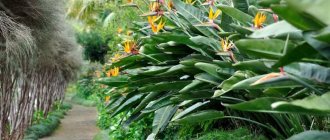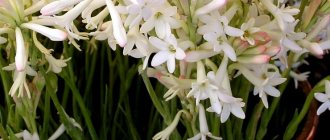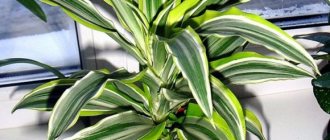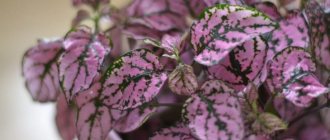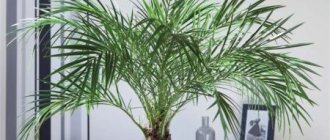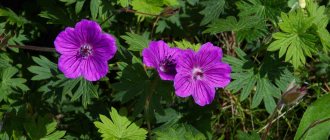Indoor bamboo is Sander's dracaena (Dracaena brauniic). Dracaena Sandera is a plant with a leafy or bare hollow stem, its shade is green or yellow-green. Naturally, the stem grows erect, but it can be twisted artificially, creating interesting compositions (spirals, lattices, etc.). The leaf blades are oblong, with pointed tips, rich green in color, located along the stem or collected at its top.
Subject to simple care rules, decorative bamboo can grow indoors for a long time. It is necessary to provide an environment as close as possible to the natural habitat.
How to properly grow bamboo at home photo
Decorative bamboo is unpretentious in care. An evergreen exotic plant will be a wonderful addition to a home or office interior and will help to maintain a Japanese-style room. Decorative bamboo can be grown in substrate or water. Regardless of the method of cultivation, Sandera's dracaena will delight you with its decorative qualities. This gives ample opportunities in choosing a container, which allows you to complement the interior in an original way. Rapid growth rates make it possible to create a cozy tropical corner or decorate a work area in a short time.
Ways to grow bamboo
There are three ways to grow bamboo at home:
- In a flower pot with soil;
- In a regular or transparent container with water (looks very impressive);
- In a transparent container with hydrogel.
To grow in the ground, you will need fairly wide and stable flower pots, since bamboo grows very quickly. Any universal mixture is suitable as soil. You can take a substrate for growing decorative leafy crops; there is a special soil mixture for dracaenas.
When growing in water, a transparent container is most often chosen. The plant is secured with decorative stones (they should first be boiled for disinfection). Water for growing and watering (when planting a plant in the soil) requires soft water - rain, melt, filtered, standing for 1-2 days, tap water.
Hydrogel is a convenient modern material for growing plants. It retains moisture, protects the root system, and becomes an unusual decorative detail. It is very easy to use - minimal watering and periodic fertilization are required.
Depending on where the bamboo is grown (soil, water or hydrogel), the care rules are slightly different. This will be discussed in more detail.
Bamboo varieties
Among the indoor varieties of this plant, the following are distinguished:
- Small sized bamboo that grows as a bush is called Kumasaza. It has a zigzag and slightly flattened trunk.
- Lucky spiral bamboo is the most common variety of indoor bamboo.
- An extremely flexible variety, Muriel, reaching up to two and a half meters in height. It is quite cold-resistant and suitable for growing in the garden.
- Bamboo Multilayer is the tallest of all. It can also be grown indoors if ceiling height allows.
- A variety called Variegated has spotted leaves and reaches a height of barely one meter.
- The variety that has a silvery stem with a glossy surface is called Brilliant.
- Bamboo Blue is the smallest among all varieties. Its dimensions barely reach half a meter.
According to Feng Shui, it is advisable to place a pot of bamboo on the east, south or southeast side. Moreover, bamboo placed in the eastern part of the apartment will bring good luck in your personal life, and in the southern part - fame and recognition from friends. If you need to improve your financial situation, then it is best to place the plant on the southeast side.
Conditions for growing bamboo Dracaena sandera
How to care for bamboo dracaena flower at home photo
Lighting
Bamboo of happiness, or Dracaena Sander, prefers bright, diffused lighting; protect from direct sunlight. The best location is windows facing east or west. When placed on the south side, allow light to pass through the tulle curtain.
If the lighting is insufficient, the growth rate will slow down and the bamboo will begin to shed its leaves.
Air temperature
The optimal temperature range for USB is 18-25 °C. The plant will normally tolerate summer heat within 30 °C.
Air humidity
How to care for bamboo at home
There are no special requirements for the level of air humidity. Periodically wipe the leaf plates with a damp soft cloth - accumulated dust does not allow the leaves to “breathe”. If the air in the room is dry, resort to spraying with a fine spray.
How to feed
Fertilizer is an important maintenance element when growing bamboo in water. Lack of fertilizing will lead to yellowing of the stem or leaf blades. Apply complex mineral fertilizers along with replacement water or irrigation water. It is enough to feed once every 2-3 months.
Happy place in the apartment
It is best to place a vase with bamboo on the eastern side of the window or closer to it. You should not leave it on a sunny windowsill, because direct rays of the sun will burn the leaves. The ideal place for bamboo in water is in partial shade. If there are no such places in the apartment, then you can place a vase with bamboo on the windowsill or floor, covering the glass with a curtain, blinds or newspaper, protecting the plant from sunburn. When ventilating the room, the plant should not be exposed to cold air, as this will have a negative effect on it.
Bamboo in water care at home
Growing bamboo in water is an easy and convenient way to grow. An aquatic environment promotes more active and harmonious growth; even in indoor conditions, bamboo varnishes can reach a height of 1-2 m. Change the water in the container once a week. If the leaves of the plant begin to turn yellow, or the water has an unpleasant odor, change the liquid immediately, rinse the pebbles and pebbles thoroughly under warm running water. It is best to keep bamboo in melt water.
How to prepare melt water:
- Fill a plastic container with water;
- Place in the freezer for two days;
- Defrost and use as intended.
Don’t forget to add fertilizing complex mineral fertilizers, you can do this once a week, diluting with water 3-4 times more than the recommended dose.
Water for bamboo
In many apartments and houses, bamboo is grown in water, because its straight or twisted shoots look very impressive in various glass vases. But then you will need to feed it with mineral fertilizers to preserve the green color of the leaves.
The water in the vase with it must be filtered, or preferably distilled, at room temperature. It must be updated every 2 weeks.
You can also use rain or melt water - pour filtered or plain tap water into a plastic bottle and place in the freezer until the water completely turns into ice. Then put the bottle to thaw at room temperature. The resulting water becomes soft and more suitable for growing bamboo in it. If the water has acquired an unpleasant odor or a suspicious color earlier than 2 weeks, then you should change it and subsequently change the water in the vase with bamboo more often. If its leaves turn yellow, then the water also needs to be changed.
Growing bamboo in a pot with soil
Bamboo care at home photo
This method of growing makes maintenance somewhat easier - you don’t have to change the water weekly or monitor its condition. In itself, the constant presence of the root system in moisture is dangerous, because rotting is possible.
During the warm season, the plant will require timely and regular watering. The soil mixture should always be slightly moist; do not allow the earthen ball to dry out. If you have transferred bamboo from an aquatic environment to soil, water it generously and carefully monitor the condition of the plant until it finally takes root. The soil should be moist, but not swampy.
Watering in the autumn-winter period should be significantly reduced - the top layer of soil should dry out between waterings. Stagnation of water is strictly unacceptable. This will lead to mold and rotting of the root system. For preventative purposes, when planting, make sure there are good drainage holes and place a drainage layer on the bottom of the container.
Growing bamboo in hydrogel
How to grow bamboo at home
Caring for a plant planted in hydrogel should be approximately the same as when growing in a substrate. Only the hydrogel does not need to be watered as often as soil. The top layer of hydrogel can dry out faster than the rest - just spray it with a fine spray or replace it with a fresh one. When applying fertilizers, reduce the concentration.
The composition should not be placed in direct sunlight, as the hydrogel may become moldy.
Hydrogel and hydroponics should not be confused. The hydrogel itself is a neutral medium (no stimulation for growth, no nutrition), which is its advantage and disadvantage at the same time.
Bamboo varnishes from seeds at home
Dracaena sandera propagates by seeds, and if you managed to get them, it's time to get a lot of lucky bamboo seedlings.
- To grow Dracaena sandera seedlings, it is preferable to take leaf soil and mix it with sand, and lay a drainage layer on the bottom of the container. This way you will be sure that young plants will not be affected by rot.
- The seeds are large enough to plant them one at a time in the cells of a seedling cassette, and then transfer them into larger cups.
Bamboo dracaena from seeds at home photo of seedlings
- If there is not enough space on the windowsill, you can sow it in a container for seedlings, and carefully plant the grown plants in separate cups, trying to hook them with a fork along with the earthen lump. When planting seeds in a container, maintain a minimum distance between seedlings of 3-4 cm.
- Seed placement depth is 0.5-1 cm.
- After sowing, the soil is sprayed with a spray bottle, the container is covered with cling film, a transparent lid or glass.
- The required temperature for germinating seeds and growing seedlings is 18-24°C.
- Lighting required is bright, diffused, long daylight hours. If you grow in a north-facing window or during the cold winter months, provide additional lighting with phytolamps to prevent the plants from stretching out.
Growing bamboo from seeds at home photo
Laki bamboo grows very quickly, and after two months you will have full-fledged seedlings that can be planted in permanent pots using the transshipment method.
All about bamboo: growing according to Feng Shui
good luck symbol
plant of happiness
The ancient teachings of Feng Shui say that this plant will become a source of good luck and happiness for the person who started growing it.
That is why quite a lot of people strive to acquire a type of Dracaena Sander, which, in fact, is called the bamboo of happiness and is perfectly grown as a houseplant.
According to the philosophy that has come to us from China, if you place a “tree of happiness” in the south-eastern room, and place a sculpture of a toad with coins next to it, then luck and financial well-being will never leave this house.
The number of stems grown in one container matters.
- If there are 3 of them, they will help attract good luck in business. It would be better to place these pots in the office.
- 5 stems symbolize personal happiness, and it is better to place such interior decoration, of course, in the bedroom.
- 7-fold stems predict strong, heroic health
- Well, in order to achieve a positive effect on all aspects of life, the Feng Shui technique recommends growing 21 stems in one pot.
A species growing wild in nature is not suitable for home conditions, and it is also unsuitable for decoration due to its enormous growth and rigid stems that cannot be intertwined. Wild bamboo plant has nothing to do with the indoor plant of the same name, moreover, they are not even relatives. In nature, where bamboo grows, it reaches as much as 50 meters in length and is considered the tallest herbaceous species. It is used by local residents to collect sap and also for construction.
Propagation of lacquer bamboo by cuttings at home
Reproduction of bamboo at home photo cuttings
Propagation by cuttings can be carried out throughout the year, but the most favorable time is spring.
- Cut the young shoot or break it off from the main plant, place it in water with a root formation stimulator for roots to appear.
- After rooting in water, plant the cutting in suitable soil.
- During the first 2-3 weeks, pay more attention to young plants: maintain the air temperature within 22-25 ° C, regularly water, spray the leaves, superficial loosening of the soil will contribute to successful rooting.
What causes bamboo
Most often, this plant is attacked by fungal mold. Bamboo is also often attacked by insect pests such as aphids or mites. At the first symptoms of the disease, it is recommended to completely treat the leaves, trunk and roots of the plant. It is taken out of the water and sprayed with a special chemical solution intended for dracaena. Sometimes the disease affects bamboo so badly that it is recommended to get rid of it.
If you wish, you can try cutting off the surviving cuttings, treating them with chemicals and placing them in a glass of water. Next, the cutting is closely monitored and, if there are no signs of disease, the shoot is left. It should be borne in mind that a flower cured after a fungus sometimes loses its shape, so many gardeners prefer to get rid of the mother stem, leaving only healthy cuttings.
How to replant bamboo at home video
Young plants (up to three years old) are replanted annually. Choose a larger container each time. Adult specimens can be replanted once every 3 years.
After transplantation, provide an adaptation period, which consists of more attentive care (described in the previous section).
Several stems planted in one container look very original. When growing in water, for convenience and additional decoration, tie them with golden or red braid.
As a container, you can use not only classic containers and flower pots, but also glass vases, glasses, deep jugs, and buckets. When the plant reaches a height of 50-80 cm, the container is placed on the floor in close proximity to the window.
How to trim bamboo at home
Strongly overgrown lacquer bamboo becomes not particularly attractive; it is advisable to prune it every spring. Remove long shoots from all sides; central trunks can be shortened by half or even almost to ground level. To make the cut look neat, make it immediately under the knot, use special scissors.
It is advisable to use the cuttings obtained after pruning for rooting. If after pruning the young shoots cannot emerge for a long time, make cuts to help them hatch.
Trim yellowed leaves and stems. Let the juice dry a little, then sprinkle the cut area with charcoal crumbs or lubricate it with soft wax.
What does it look like
Dracaena sandera is a perennial evergreen plant with attractive characteristics:
- The flower has a fleshy segmented stem, with characteristic constrictions reminiscent of bamboo. Initially plastic, over time the stem hardens, especially at the junction of the segments.
One of the varieties of dracaena Source fermer.blog
- The top is crowned with light green, single-color, lanceolate-shaped leaves, glossy in appearance and dense to the touch. Some hybrid varieties have more interesting leaf colors: stripes or with a border around the edge, light or dark.
- When grown indoors, dracaena grows to a height of up to one meter.
Composition of several stems Source www.hortipoint.nl
- Not all varieties bloom at home, and flowering itself occurs rarely and coincides with the warm season. Small white buds are collected in inflorescences.
- The leaves and stems of dracaena are mildly toxic and can cause symptoms of poisoning in a dog or cat that tries them.
Be careful with pets!
Source mothership.sg In specialized stores you can most often find dracaena with a spiral-shaped stem; This is how they represent it: “spiral bamboo.” A barrel twisted into a spiral is not a natural feature; the effect is created artificially.
The stem of a young plant, until it becomes woody, is particularly flexible and pliable. Gardeners have learned to use this property by practicing bending shoots in different ways. After the plants reach a certain age, the auxiliary parts are removed, and the shoot retains its spiral shape.
In Asian style Source deloindom.delo.si
How to twist bamboo at home
Bamboo spiral care at home
Many people want not only to grow bamboo at home, but also to give its trunk an unusual shape. The most common option is the spiral type of curling. This will require patience and special care:
- When planting, place the young cutting horizontally and temporarily (when buds form) cover it completely with something non-transparent, making a small hole for light to penetrate. The sprout will tend to the light source, and in order to curl it, you will need to rotate the plant or structure itself. The most suitable design option is a cardboard box. With this method, you can curl only one spiral per year.
- Place the cutting horizontally in the water - the plant will grow rapidly to rise to the top. Rotate the plant when the direction of the trunk changes slightly. The disadvantage is that the plant may begin to produce roots, and shoot growth will slow down.
- The sprouts are carefully wound onto the rod, securing the stems with wire. As they grow, the stems will become stronger and stronger - remove the entire structure and leave the trunk in this position.
Difficulties in growing bamboo indoors
When growing bamboo, a number of problems are possible:
Leaves and trunk turn yellow
This happens for a number of reasons: lack of moisture, watering with poor-quality water, increased indoor temperature, excess fertilizer, sunburn, exposure to a draft; when grown in water - untimely replacement of liquid. First, identify and eliminate the cause. Remove the affected leaves, cut the trunk below the yellowing zone (it will not recover).
Bamboo grows very slowly
This is due to a lack of nutrients (especially when grown in water). Another reason is dim lighting. Maintain the correct feeding regimen and take care of good lighting.
Leaf blades become limp and curled
The reasons are hypothermia (keeping the air temperature too low) or drafts.
Why do black spots appear on bamboo leaves?
This signals a fungal infection. To save the plant, you will need to spray it with a fungicide.

